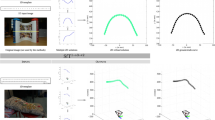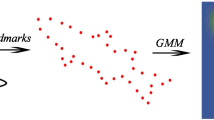Abstract
We develop a simple, yet powerful, technique based on linear regression models of parametrized closed curves which induces a probability distribution on the planar shape space. Such parametrization is driven by control points which can be estimated from the data. Our proposal is capable to infer about the mean shape, to predict the shape of an object at an unobserved location, and, while doing so, to consider the effect of predictors on the shape. In particular, the model is able to detect possible differences across the levels of the predictor, thus also applicable for two-sample tests. A simple MCMC algorithm for Bayesian inference is also presented and tested with simulated and real datasets. Supplementary material is available online.





Similar content being viewed by others
References
Bhattacharya A, Bhattacharya R (2012) Nonparametric inference on manifolds with applications to shape spaces. Cambridge University Press, Cambridge
Bookstein FL (1996a) Applying landmark methods to biological outline data. In: Mardia KV, Gill CA, Dryden IL (eds) Proceedings in image fusion and shape variability techniques. University of Leeds Press, Leeds, pp 368–369
Bookstein FL (1996b) Landmark methods for forms without landmarks: morphometrics of group differences in outline shape. Med Image Anal 1:225–243
Brignell C, Dryden I, Gattone S, Stuart B, Browne W, Flynn S (2010) Surface shape analysis with application to brain surface asymmetry in schizophrenia. Biostatistics 11:609–630
Cardini A, Nagorsen D, O’Higgins P, Polly P, Thorington J, Tongiorgi P (2009) Detecting biological uniqueness using geometric morphometrics: an example case from the Vancouver Island marmot. Ecol Ethol Evol 21:209–223
Chiari Y, Claude J (2012) Morphometric identification of individuals when there are more shape variables than reference specimens: a case study in Galapagos tortoises. CR Biol 335(1):62–68
Claude J (2008) Morphometrics with R. Springer, New York
Collyer M, Hall M, Smith M, Hoagstrom C (2015) Habitat-morphotype associations of Pecos Pupfish (Cyprinodon pecosensis) in isolated habitat complexes. Copeia 1:181–199
Dryden I (2005) Statistical analysis on high-dimensional spheres and shape spaces. Ann Stat 33:1643–1665
Dryden IL (2016) shapes package, R Foundation for Statistical Computing, Vienna, Austria. Contributed package, Version 1.1-13. http://www.R-project.org
Dryden IL, Mardia K (1998) Statistical shape analysis. Wiley, Chichester
Dryden IL, Mardia K (2016) Statistical shape analysis with application in R. Wiley, Chichester
Ellingson L, Patrangenaru V, Ruymgaart F (2013) Nonparametric estimation of means on Hilbert manifolds and extrinsic analysis of mean shape of contours. J Multivar Anal 122:317–333
Fabic J, Turla I, Capacillo J, David L, Naval P (2013) Fish population estimation and species classification from underwater video sequences using blob counting and shape analysis. In: Underwater Technology Symposium (UT), 2013 IEEE International. https://doi.org/10.1109/UT.2013.6519876
Goodall C (1991) Procrustes methods in the statistical analysis of shape. J R Stat Soc Ser B 53:285–339
Gower J (1975) Generalized procrustes analysis. Psychometrika 40:33–50
Green WD (1996) The thin-plate spline and images with curving features. In: Mardia KV, Gill CA, Dryden IL (eds) Proceedings in image fusion and shape variability techniques. University of Leeds Press, Leeds, pp 79–87
Gu K, Pati D, Dunson DB (2014) Bayesian multiscale modeling of closed curves in point clouds. J Am Stat Assoc 109(508):1481–1494
Juhász I, Róth A (2010) Closed rational trigonometric curves and surfaces. J Comput Appl Math 234(8):2390–2404
Kendall D (1977) The difussion of shape. Adv Appl Probab 9:428–430
Klassen E, Srivastava A, Mio W, Joshi SH (2004) Analysis of planar shapes using geodesic paths on shape spaces. IEEE Trans Pattern Anal Mach Intell 26:372–383
Kurtek S, Klassen E, Ding Z, Avison M, Srivastava A (2011) Parameterization-invariant shape statistics and probabilistic classification of anatomical surfaces. In: Information processing in medical imaging: proceedings of the conference, IMPI 2011, vol 22, 147–158
Loy A, Corti M, Marcus L ( 1993) Contribution to Morphometrics, Madrid: Museo Nacional de Ciencias Naturales, chapter Landmark data: size andshape analysis in systematics. A case study on Old World Talpidae (Mammalia, Insectivora), pp 213–240
Micheas A, Dey D, Mardia K (2006) Complex elliptical distributions with application to shape analysis. J Stat Plan Inference 136:2961–2982
Pati D, Dunson D (2016) Bayesian fitting of closed surfaces through tensor products. J Mach Learn Res (accepted)
Patrangenaru V, Ellingson L (2015) Nonparametric statistics on manifolds and their applications to object data analysis. Chapman and Hall/CRC monographs on statistics and applied probability. CRC Press, Boca Raton
Róth A, Juhász I (2010) Control point based exact description of a class of closed curves and surfaces. Comput Aided Geom Des 27:179–201
Róth A, Juhász I, Schicho J, Hoffmann M (2009) A cyclic basis for closed curve and surface modeling. Comput Aided Geom Des 26:528–546
Srivastava A, Joshi S, Kaziska D, Wilson D (2005) Applications of planar shape analysis to image-based inferences. In: Proceedings of the IEEE international conference acoustics, speech, and signal processing (ICASSP ’05), pp 1037–1040
Viscosi V, Cardini A (2011) Leaf morphology, taxonomy and geometric morphometrics: a simplified protocol for beginners. PLoS ONE 6(10):e25630
Acknowledgements
The first author was partially funded by Fondecyt Grant 11140013. The second and third authors were supported by CONACyT Grant 241195. This work was carried out while the first author held a Visiting Research Chair—Cátedra de Investigación—position at IIMAS-UNAM. The authors have declared no conflict of interest. The authors are grateful for the fine and constructive comments made by an anonymous referee.
Author information
Authors and Affiliations
Corresponding author
Electronic supplementary material
Below is the link to the electronic supplementary material.
Appendix
Appendix
Algorithm 1
The Gibbs sampling for model (4) when R is fixed is given by the following full conditional distributions
- (1)$$\begin{aligned} (\theta _i\mid \ldots ) \sim N_d(\tilde{\theta }_i, \tilde{\Sigma }_{\theta }), \end{aligned}$$
where \(\tilde{\Sigma }_{\theta }=[nZ^T\Omega ^{-1}Z+\Sigma _{\delta }^{-1}]^{-1}\) and \(\tilde{\theta _i}=\tilde{\Sigma }_{\theta }[Z^T\Omega ^{-1}Y_i+\Sigma _{\delta }^{-1}\varvec{\theta }X_i].\)
- (2)$$\begin{aligned} (\Sigma _{j}\mid \ldots ) \sim IW_{2}(\delta _{0}+n, A_{0}+\sum _{i=1}^{n}(Y_{ij}-Z_{ij}\theta _{i})(Y_{ij}-Z_{ij}\theta _{i})^{T}), \end{aligned}$$
where \(Y_{ij}=(y_{j,\textsf {x}}, y_{j,\textsf {y}})^{T}\), \(j=1,\ldots ,k\) and \(Z_{ij}\) is the matrix defined in (3).
- (3)$$\begin{aligned} (\theta _j\mid \ldots ) \sim N(\tilde{\theta }_j,\tilde{\Sigma }_{\theta _j}), \quad j=1,\ldots ,q \end{aligned}$$
where \(\tilde{\Sigma }_{\theta _j}=[\sum _{i=1}^n x_{ij}^2\Sigma _{\delta }^{-1}+ B_0^{-1}]^{-1}\) and
$$\begin{aligned} \tilde{\theta }_j=\tilde{\Sigma }_{\theta _j}\left[ \sum _{i=1}^n x_{ij}\Sigma _{\delta }^{-1} \theta _i-\sum _{s\ne j}\sum _{i=1}^n x_{ij}x_{is}\Sigma _{\delta }^{-1}\theta _{s}+B_0^{-1}\theta _0 \right] \end{aligned}$$ - (4)$$\begin{aligned} (\Sigma _{\delta }\mid \ldots ) \sim IW(\nu +n, D_0+\sum _{i=1}^n( \theta _i-\varvec{\theta }X_i)(\theta _i-\varvec{\theta }X_i)^T). \end{aligned}$$
Rights and permissions
About this article
Cite this article
Gutiérrez, L., Mena, R.H. & Díaz-Avalos, C. Linear models for statistical shape analysis based on parametrized closed curves. Stat Papers 61, 1213–1229 (2020). https://doi.org/10.1007/s00362-018-0986-0
Received:
Revised:
Published:
Issue Date:
DOI: https://doi.org/10.1007/s00362-018-0986-0




